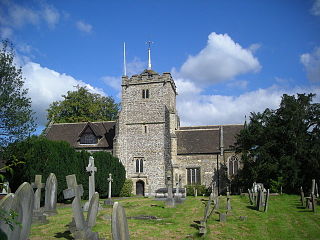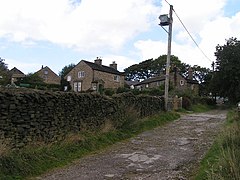
Warnham is a village and civil parish in the Horsham district of West Sussex, England. The village is centred 2 miles (3.2 km) NNW of Horsham, 31 miles (50 km) from London, to the west of the A24 road. Other named settlements within the parish include the hamlets of Goosegreen, Kingsfold and Winterfold as well as parts of Strood Green and Rowhook. The area is in the northwest of the Weald, a gently sloped remnant forest in southeast England and largely a plain by erosion this does not help.

Edwardstone is a village and civil parish in the Babergh district, in the county of Suffolk, England. The parish contains the hamlets of Mill Green, Priory Green, Round Maple and Sherbourne Street, and Edwardstone Woods, a Site of Special Scientific Interest.

Stanford Rivers is a village and civil parish in the Epping Forest district of Essex, England. The parish, which is approximately 11 miles (18 km) east from the county town of Chelmsford, contains the village of Toot Hill and the hamlet of Little End, both settlements larger than Stanford Rivers village, and the hamlet of Clatterford End. The village is 2.0 miles (3 km) south-east of Chipping Ongar, 3 miles (5 km) south-west of North Weald Bassett and 3 miles north-west of Kelvedon Hatch. The parish covers an area of 1,749 hectares.

Chunal is a hamlet in Derbyshire, England. It is located on the A624 road, 1 mile south of Glossop. The philosopher Ludwig Wittgenstein conducted aeronautical research at Chunal during his time as an engineering research student at Manchester University (1908–1911). He flew kites into the upper atmosphere.

Mellor Hall is a country hall in Mellor, Greater Manchester, England, 0.4 miles (0.64 km) north of The Devonshire Arms off Longhurst Lane.

As of 2011 there were 102 listed buildings and structures in the English borough of Crawley, West Sussex. Two others have subsequently gained listed status. The Borough of Crawley is based on the town of the same name, located approximately halfway between London and Brighton. Although Crawley expanded substantially after World War II when it was designated a New Town by an Act of Parliament, many older buildings remain.

Hastingwood is a hamlet in the North Weald Bassett civil parish of the Epping Forest district of Essex, England. The hamlet is centred on the junction of Hastingwood Road, which runs southwest to the A414 road and the Hastingwood Junction 7 of the M11 motorway, and Mill Street, which runs north to Harlow Common and Potter Street. Nearby settlements include the town of Harlow, North Weald and the hamlet of Foster Street.
New Mills is a civil parish in High Peak, Derbyshire. It contains 65 listed buildings, which are designated by Historic England and recorded in the National Heritage List for England. Of these, one is listed at Grade II*; the rest are at Grade II. Hague Bridge and Borderstone/Hope Cottage have two listings, as they span parish boundaries.
Heskin is a civil parish in the Borough of Chorley, Lancashire, England. It contains 17 buildings that are recorded in the National Heritage List for England as designated listed buildings. Of these, one is listed at Grade I, the highest of the three grades, one is at Grade II*, the middle grade, and the others are at Grade II, the lowest grade. The parish is almost completely rural, and most of the listed buildings are, or originated as, farmhouses and farm buildings. The other listed buildings are large houses and associated structures, and a cottage.
Wheelton is a civil parish in the Borough of Chorley, Lancashire, England. It contains twelve buildings that are recorded in the National Heritage List for England as designated listed buildings, all of which are listed at Grade II. This grade is the lowest of the three gradings given to listed buildings and is applied to "buildings of national importance and special interest". Apart from the villages of Wheelton and Higher Wheelton, the parish is rural, and many of the listed building are, or originated as, farmhouses and farm buildings. The Leeds and Liverpool Canal passes through the parish, and associated with this are three listed bridges. The other listed buildings are two sets of weavers' cottages.
Over Wyresdale is a civil parish in Lancaster, Lancashire, England. It contains 53 buildings that are recorded in the National Heritage List for England as designated listed buildings. Of these, one is at Grade II*, the middle grade, and the others are at Grade II, the lowest grade.
Scotforth is a civil parish in Lancaster, Lancashire, England. It contains five listed buildings that are recorded in the National Heritage List for England. All of the listed buildings are designated at Grade II, the lowest of the three grades, which is applied to "buildings of national importance and special interest". The parish is mainly rural, and four of the listed buildings are houses, farmhouses and farm buildings. The other listed structure is a bridge crossing the River Conder that passes through the parish.
Blindbothel is a civil parish in the Borough of Allerdale in Cumbria, England. It contains 31 listed buildings that are recorded in the National Heritage List for England. Of these, two are listed at Grade I, the highest of the three grades, one is at Grade II*, the middle grade, and the others are at Grade II, the lowest grade. The parish is almost completely rural. It contains the village of Blindcrake, the hamlets of Redmain and Sunderland, and the scattered settlement of Isel. Almost all the listed buildings are in or near these settlements, and most of them are houses and associated structures, or farmhouse and farm buildings. The other listed buildings are a church, a table tomb in the churchyard, a bridge, a milestone, a watermill, and a covered well.
Murton is a civil parish in the Eden District, Cumbria, England. It contains eleven listed buildings that are recorded in the National Heritage List for England. Of these, two are listed at Grade II*, the middle of the three grades, and the others are at Grade II, the lowest grade. The parish contains the villages of Murton and Hilton and the hamlet of Brackenber, and is otherwise rural. Most of the listed buildings are houses and associated structures, farmhouses and farm buildings, the other buildings consisting of two village pumps, a bridge, and a disused railway viaduct.
Ramsbottom is a town in the Metropolitan Borough of Bury, Greater Manchester, England, and includes the villages of Holcombe and Summerseat and the surrounding countryside. The area is unparished, and it contains 51 listed buildings that are recorded in the National Heritage List for England. Of these, one is listed at Grade II*, the middle grade, and the others are at Grade II, the lowest grade. The area is partly agricultural, partly industrial, and partly residential. The listed buildings include farmhouses and farm buildings, private houses and associated structures, churches and items in churchyards, a hotel, public houses, an engineering works and a mill, a former railway goods shed, a monument, and a telephone kiosk.
Wardle is a village in the Metropolitan Borough of Rochdale, Greater Manchester, England, and it is unparished. The village, together with the nearby settlement of Smallbridge and the surrounding countryside, contains 27 listed buildings that are recorded in the National Heritage List for England. All the listed buildings are designated at Grade II, the lowest of the three grades, which is applied to "buildings of national importance and special interest". The area is largely rural and agricultural, although the textile industry came to the town as a result of the Industrial Revolution. Included in the listed buildings are houses containing multi-light mullioned weavers' windows, and a mill. Most of the listed buildings are houses and associated structures, farmhouses and farm buildings. The other listed buildings include churches, a public house, a bridge and two war memorials.
Bredbury and Romiley are towns in the Metropolitan Borough of Stockport, Greater Manchester, England. The towns, together with the area of Woodley and the village of Compstall and the surrounding countryside, contain 43 listed buildings that are recorded in the National Heritage List for England. Of these, two are listed at Grade II*, the middle grade, and the others are at Grade II, the lowest grade.
Marple is a town in the Metropolitan Borough of Stockport, Greater Manchester, England. The town, together with the villages of High Lane, Marple Bridge, Mellor, and Strines, and the surrounding countryside, contains 141 listed buildings that are recorded in the National Heritage List for England. Of these, one is listed at Grade I, the highest of the three grades, three are at Grade II*, the middle grade, and the others are at Grade II, the lowest grade.
Dawley Hamlets is a civil parish in the district of Telford and Wrekin, Shropshire, England. The parish contains 14 listed buildings that are recorded in the National Heritage List for England. All the listed buildings are designated at Grade II, the lowest of the three grades, which is applied to "buildings of national importance and special interest". The parish includes the settlements of Dawley, Doseley, and Horsehay. The listed buildings include houses and cottages, a farmhouse, a former canal aqueduct and bridge, a chapel, a church, offices, and a railway bridge.
Sheinton is a civil parish in Shropshire, England. It contains nine listed buildings that are recorded in the National Heritage List for England. Of these, one is listed at Grade II*, the middle of the three grades, and the others are at Grade II, the lowest grade. The parish contains the village of Sheinton and the surrounding countryside. Most of the listed buildings are farmhouses, the others being a church, a cottage, a barn, a former mill, and a former rectory.










